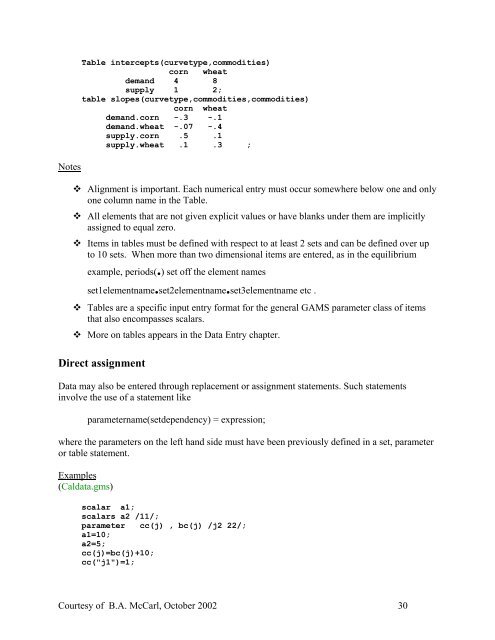You also want an ePaper? Increase the reach of your titles
YUMPU automatically turns print PDFs into web optimized ePapers that Google loves.
Notes<br />
Table intercepts(curvetype,commodities)<br />
corn wheat<br />
demand 4 8<br />
supply 1 2;<br />
table slopes(curvetype,commodities,commodities)<br />
corn wheat<br />
demand.corn -.3 -.1<br />
demand.wheat -.07 -.4<br />
supply.corn .5 .1<br />
supply.wheat .1 .3 ;<br />
Alignment is important. Each numerical entry must occur somewhere below one and only<br />
one column name in the Table.<br />
All elements that are not given explicit values or have blanks under them are implicitly<br />
assigned to equal zero.<br />
Items in tables must be defined with respect to at least 2 sets and can be defined over up<br />
to 10 sets. When more than two dimensional items are entered, as in the equilibrium<br />
example, periods(.) set off the element names<br />
set1elementname.set2elementname.set3elementname etc .<br />
Tables are a specific input entry format for the general GAMS parameter class of items<br />
that also encompasses scalars.<br />
More on tables appears in the Data Entry chapter.<br />
Direct assignment<br />
Data may also be entered through replacement or assignment statements. Such statements<br />
involve the use of a statement like<br />
parametername(setdependency) = expression;<br />
where the parameters on the left hand side must have been previously defined in a set, parameter<br />
or table statement.<br />
Examples<br />
(Caldata.gms)<br />
scalar a1;<br />
scalars a2 /11/;<br />
parameter cc(j) , bc(j) /j2 22/;<br />
a1=10;<br />
a2=5;<br />
cc(j)=bc(j)+10;<br />
cc("j1")=1;<br />
Courtesy of B.A. McCarl, October 2002 30
















